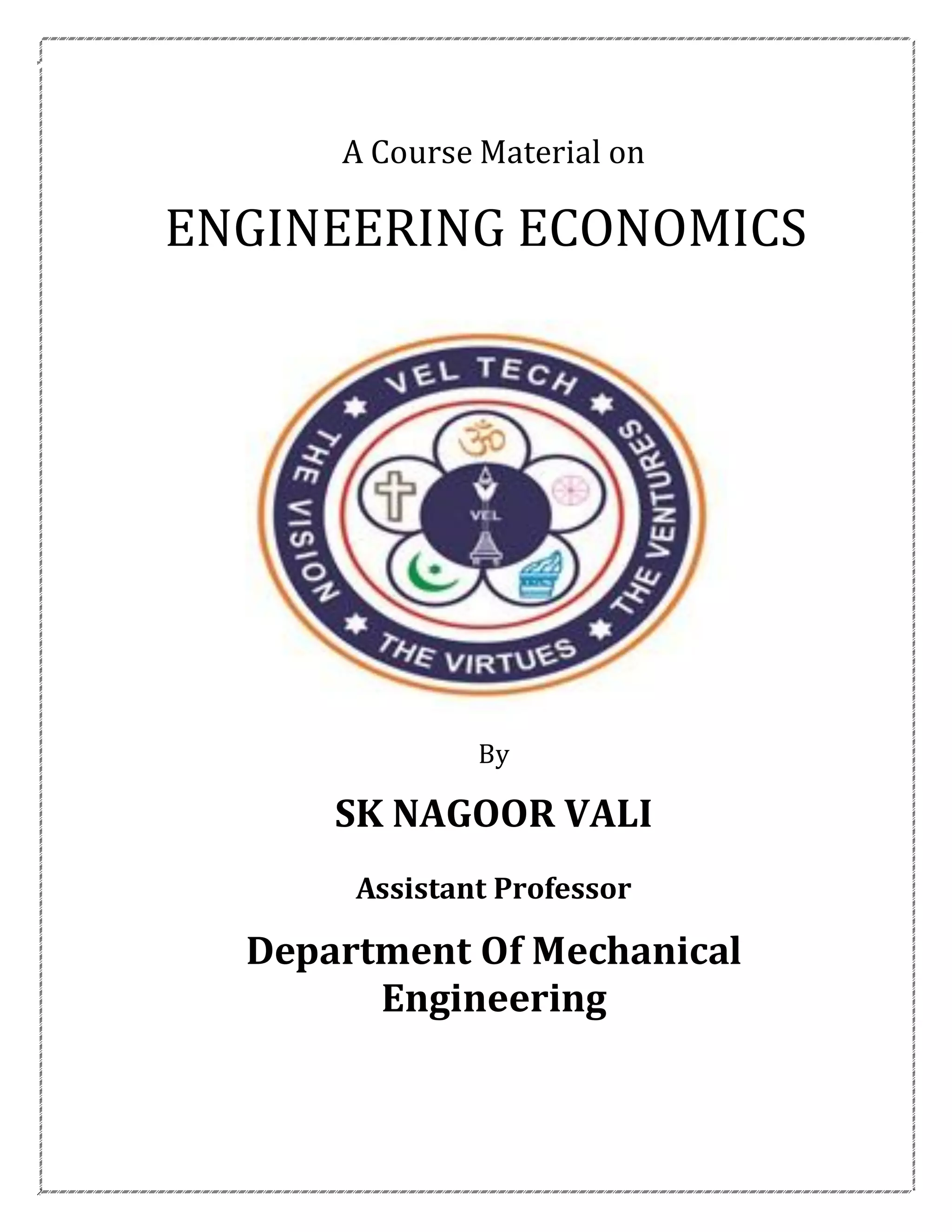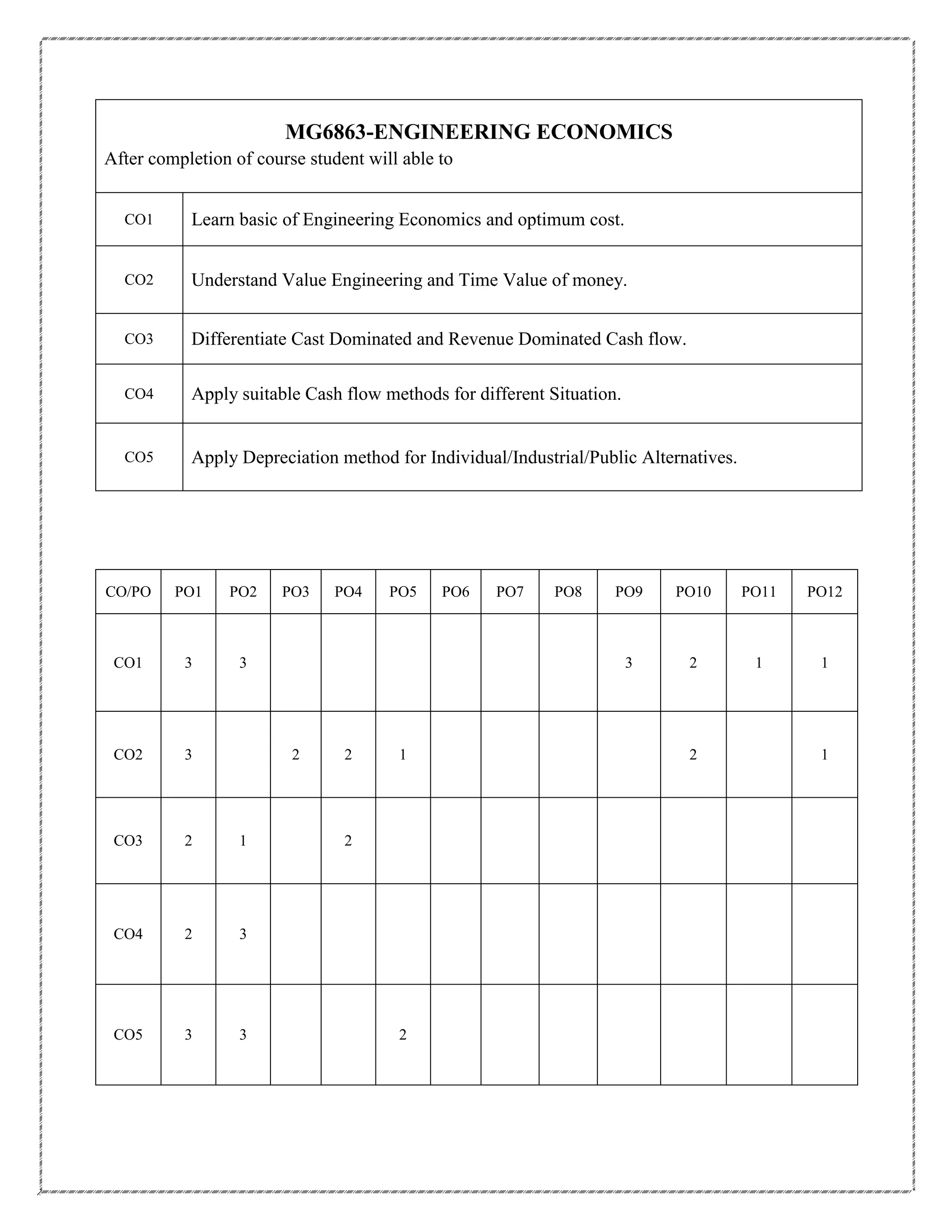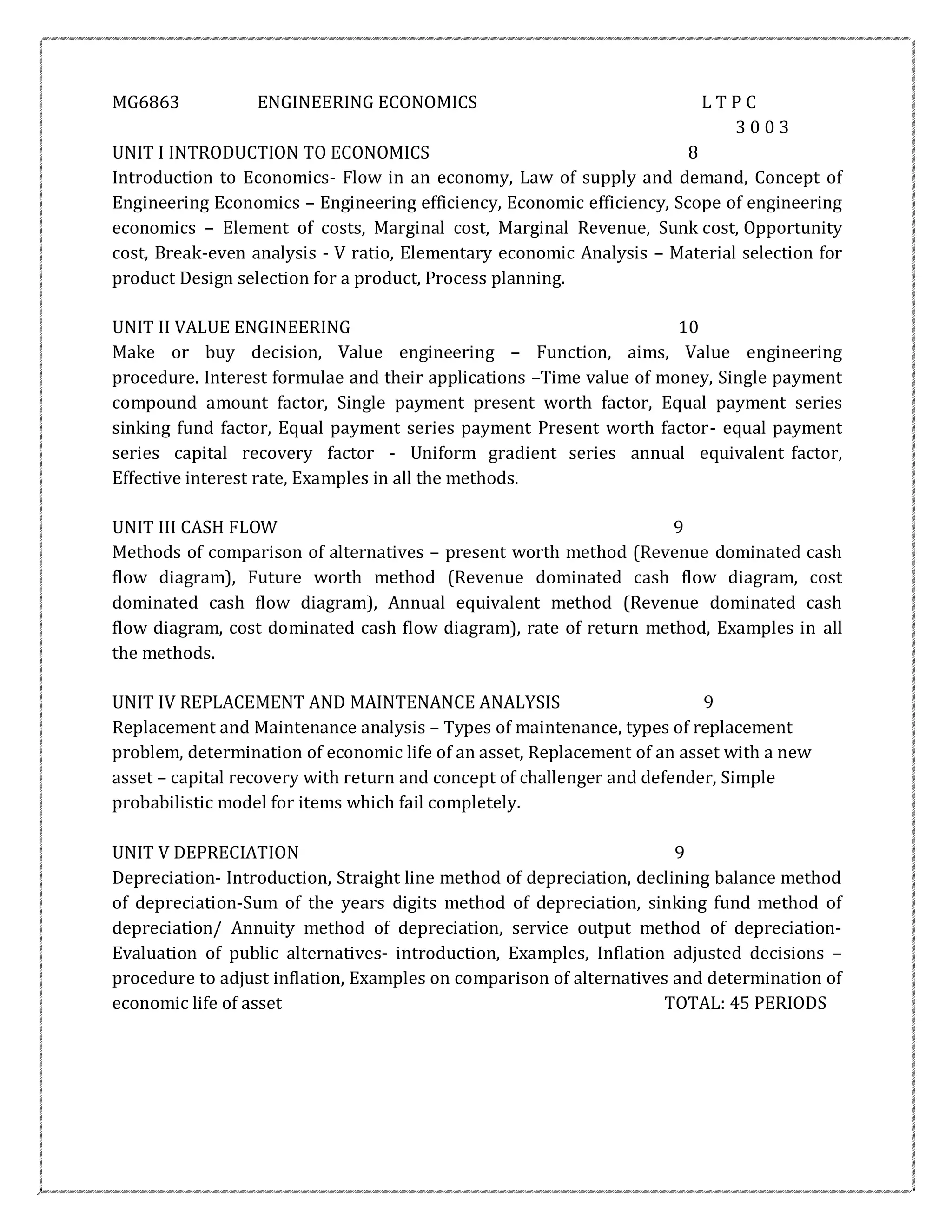This document provides information about a course on engineering economics taught at a mechanical engineering department. It includes 5 course outcomes related to learning basic engineering economics concepts, time value of money, cash flow methods, depreciation methods, and applying economic principles to alternatives. The course covers topics like introduction to economics, value engineering, cash flow methods, replacement and maintenance analysis, and depreciation over 4 units. It lists learning resources like textbooks and references for further study.




![UNIT -1
INTRODUCTION TO ECONOMICS
1. Definition of economics [April / May 2013]
Economics as a science of wealth, it is both a theoretical and practical science it
provides not only theoretical knowledge but also helps to solve many day to day problems
facing the humanity.
2. State the importance of engineering economics. [April / May 2013]
Increasing productivity and production
Reducing human effort in the increase of wealth Scanning of
external factors such as firm‘s environment Scanning of
internal factors such firm‘s operational decisions
3. What do you mean by factors of production? [ Nov / Dec 2014]
They are land, labour, capital and organization. The demand for a factor of production is not
a direct demand. It is an indirect or derived demand; it is derived from the demand for the
products that factors produce.
4. Explain the relationship between economic decision and technical decision. [Nov
/ Dec 2014]
Economic decision- it is focus on the maximum profit on minimum cost and then to
achieve the socio economic goal.
Technical decision- it is to achieve the company goals to determine the feedback
system basis to change the objective of company goals.
5. Draw the break even chart. [Nov / Dec 2013]
A break even chart is a graphical representation of marginal costing. It is also indicates the
estimated profit or loss at various levels of output. It is a graph showing he amounts of
fixed variable costs and the sales revenue at different volumes of operation.
6. Why does the demand curve slope down wards? [ Nov / Dec 2013]
When price falls, the marginal utility of the commodity in relation to money also falls,
and so the quantity demanded increases. The income effect induces the consumer to
purchase more. A fall in the price of a commodity makes it cheaper in relation to other
commodities.
7. What do you mean by break even analysis? [ Nov / Dec 2012]
It is a tool for analyzing the financial aspect whereby the impact on profit of the changes in
volume price costs and sales mix can be estimated with higher level accuracy.](https://image.slidesharecdn.com/engineeringeconomics-190211071421/75/two-marks-with-answers-5-2048.jpg)
![8. Define margin of safety. [Nov / Dec 2012]
Margin safety may be defined as the excess of actual sales or production at the
selected activity over break even sales or production. Simply margin of sales is excess
sales over the break even sales .it is abbreviated as mos.
9. What is p/v ratio? [ April / May 2010]
It is an important tool in decision making. It is used for the calculation of BEP and in
problems regarding profit and sales relationship. A higher P/V ratio indicates the greater
profitability and vice versa. So the organization makes necessary effort to obtain higher p/v
ratio.
10. Write the merits and demerits on break even chart. [April / May 2012]
Assumption- all costs are segregated into fixed and variable cost. Total fixed costs are
constant at all levels of output, production and sales figures are same variable costs
vary proportionately with the level of volume of output.
Merits- preparation of flexible budget, formulation of price policy, it provides guidance
for cost control, total profit could be calculated accurately.
Demerits- fixed cost does not always remain constant, it ignores economies of scale in
production, and variable cost does not always vary proportionately.
UNIT -2
VALUE ENGINEERING
1. What is financial management? [April / May 2013]
It is concerned with the duties of the financial managers in the business firm. Financial
Management is a operational activity of a business that is responsible for obtaining and
effectively utilizing the funds for necessary for efficient operation of business.
2. What are the sources of finance? [April / May 2013]
The source of capita debt and equity Equity- equity capital, preference capital, internal
accruals. Debt—term loans, debentures, working capital advances, miscellaneous
sources.
3. What is the internal generation of funds? [Nov / Dec 2014]
A quantifiable mathematical rate that portrays how quickly a bank is able to generate
equity capital. The Internal capital Generation Rate (ICGR) is calculated by dividing the
bank retained earnings by the average balance of the combined equity of all stockholder for
a given accounting period. The bank retained earnings are found by subtracting dividends
paid from net income.](https://image.slidesharecdn.com/engineeringeconomics-190211071421/75/two-marks-with-answers-6-2048.jpg)
![4. What do you mean by shares? [Nov / Dec 2014]
The holder of a share is the owner of the company there is no question offering any
security to shareholders they being owners of the company.
5. What is fund flow statement [ Nov / Dec 2013]
A statement of sources and application of funds is a technical device, designed to analyze
the changes in the financial conditions of a business enterprise between two balance sheet
dates.
6. What is balance sheet? [Nov / Dec 2013]
A balance sheet is a statement which is prepared for the purpose of finding out the
assets and liability position of the concern for the particular period.
7. What are the managerial uses and limitations of fund flow statement? [C Nov /
Dec 2012]
It is not substitute for a financial statement. It gives only some information‘s about changes
in working capital alone; it indicates only the past year‘s performance and not for the
future.it cannot show much accuracy.
8. What is working capital finance? [Nov / Dec 2012]
Working capital is the excess of current assets over current liabilities. Net working
capital- current asset - current liabilities.
9. What are the limitations of financial statement? [April / May 2010]
It is ignores the changes in price level, the records of past events only many items in the
financial statement are based on personal judgment of the accountant.
10. What is commercial paper? [ April / May 2010]
It represents short term unsecured promissory notes issued by firms which enjoy a fairly
high credit rating. It is large firms with considerable financial strength are able to issue a
commercial paper.](https://image.slidesharecdn.com/engineeringeconomics-190211071421/75/two-marks-with-answers-7-2048.jpg)
![UNIT -2
CASH FLOW
1. What is marginal cost pricing? [April / May 2013]
Marginal cost is a production and economics calculation that tells you the cost of producing
additional items. You must know several production variables, such as fixed costs and
variable costs in order to find it.
2. What is capital budgeting? [April / May 2013]
Capital budgeting is a process used by companies for evaluating and ranking potential
expenditures or investments that are significant in amount. The large expenditures
could include the purchase of new equipment, rebuilding existing equipment,
purchasing delivery vehicles, constructing additions to buildings, etc. The large amounts
spent for these types of projects are known as capital expenditures.
3. What is payback period? [Nov / Dec 2014]
Payback period is the time in which the initial cash outflow of an investment is expected to
be recovered from the cash inflows generated by the investment. It is one of the simplest
investment appraisal techniques.
The formula to calculate payback period of a project depends on whether the cash flow
per period from the project is even or uneven. In case they are even, the formula to
calculate payback period is:
Payback Period =
Initial Investment
Cash Inflow per Period
When cash inflows are uneven, we need to calculate the cumulative net cash flow for
each period and then use the following formula for payback period.
4. What is NPV? [ Nov / Dec 2014]
The difference between the present value of the future cash flows from an investment and
the amount of investment. Present value of the expected cash flows is computed by
discounting them at the required rate of return.
5. What is bid pricing? [May/June 2015]
The bid price represents the maximum price that a buyer or buyers are willing to pay for a
security.
6. What is feasibility? [ May/June 2015]
A feasibility study looks at the viability of an idea with an emphasis on identifying
potential problems he information you gather and present in your feasibility study will
7. How to preparation of feasibility report? [Nov / Dec 2013]](https://image.slidesharecdn.com/engineeringeconomics-190211071421/75/two-marks-with-answers-8-2048.jpg)
![A feasibility study may be necessary for a variety of projects, including many business
studies for the expansion or continued operation of a company or small business, as
well as other types of proposed projects like public works initiatives.
8. What is the relationship between marginal cost and average cost? [ Nov / Dec
2013]
The relationship between MC AND AC is exactly of the similar nature. The relation between
this MC AND AC is more a mathematical one rather than economics. Because of the small
output MC and AC must be the same.
9. What is the difference between fixed cost and variable cost. [ Nov / Dec 2012]
Fixed cost remains fixed irrespective of the level of output ex. Rent salaries, insurance etc.
Variable cost- this cost varies with the volume of output ex- direct material, direct labour,
direct expenses, selling commission etc.
10. What are the elements of cost? [ Nov / Dec 2012]
There are broadly three elements of cost - (1) material, (2) labour and (3) expenses. Direct
Material: All materials which become an integral part of the finished j product, the cost of
which are directly and completely assigned to the specific physical units and charged
to the prime cost, are known as direct material. Direct labour is all labour
expended and directly involved in altering the condition, composition or construction of
the product. Direct Expenses: Expenses which are specifically incurred and can be directly
and wholly allocated to a particular product, job or service are termed as 'direct expenses'
UNIT - 4
REPLACEMENT AND MAINTENANCE ANALYSIS
1. What are the major forms of Organization? [ April / May 2013]
1. Sole Proprietorship,
2. Joint Hindu Family Business,
3. Partnership,
4. Joint Stock Company,
5. Co-operative Society](https://image.slidesharecdn.com/engineeringeconomics-190211071421/75/two-marks-with-answers-9-2048.jpg)
![2. Define State Enterprise. [April / May 2013]
― Public enterprise means state ownership and operation of industrial, agricultural,
financial and commercial undertaking‖- A.K.Hansen
3. What is Mixed Economy? [ Nov / Dec 2014]
Capitalism has some merits and defects. Socialism has some merits and demerits .If the
merits of the two
System are Combined by judicious policy there will be greater welfare of the society.
4. What are the type of Banks? [Nov / Dec 2014]
Commercial Bank
Agriculture Bank
Industrial Bank
Central Bank
5. Define Commercial Bank? [ Nov / Dec 2013]
― The accepting for the purpose of lending or investment ,deposits of money from the
public repayable on demand or otherwise and withdrawable by cheque, draft order or
otherwise‖
6. List out any Four functions of Commercial Bank. [Nov / Dec 2013]
Acceptance of Deposit
Advancing of Loans
Investment of funds
Purchase and sale of foreign Exchange
7. List out the objective of Monetary Policy. [CO4 - L1 - April / May 2010]
Full employment
Price stability
Stimulating economic growth.
UNIT -5
DEPRECIATION](https://image.slidesharecdn.com/engineeringeconomics-190211071421/75/two-marks-with-answers-10-2048.jpg)
![1. What do you mean by break even analysis? [April / May 2013]
It is a tool for analyzing the financial aspect whereby the impact on profit of the changes in
volume price costs and sales mix can be estimated with higher level accuracy.
2. Define margin of safety. [April / May 2013]
Margin safety may be defined as the excess of actual sales or production at the
selected activity over break even sales or production. Simply margin of sales is excess
sales over the break even sales .it is abbreviated as mos.
3. What is p/v ratio? [ Nov / Dec 2014]
It is an important tool in decision making. It is used for the calculation of BEP and in
problems regarding profit and sales relationship. A higher P/V ratio indicates the greater
profitability and vice versa. So the organization makes necessary effort to obtain higher p/v
ratio.
4. What is making or buy decision? [Nov / Dec 2014]
The outside price of the component is lower than the marginal cost of producing it is worth
buying, if the outside price is higher than the marginal cost making the component in the
factory may be preferred.
5. What is angle of incidence? [ Nov / Dec 2013]
It indicates the profit earning capacity the angle is formed at the breakeven point where the
sales line cuts the total cost line. The angle may be large or small. Large angle of incidence
indicates higher profit rate and vice versa.
6. Write the merits and demerits on break even chart. [ Nov / Dec 2013]
Assumption- all costs are segregated into fixed and variable cost. Total fixed costs are
constant at all levels of output, production and sales figures are same variable costs
vary proportionately with the level of volume of output.
7. What are the managerial uses of break-even analysis? [Nov / Dec 2012]
It is very useful for forecasting and profits. Long term planning and growth the chart
discloses profits at various levels of production. It can also be used to study the
comparative plant efficiencies of the industry.
8. Differentiate market price and normal price. [ Nov / Dec 2012]
Market price prevails in the very short period It is the result of temporary equilibrium
between demand and supply Market price is more influenced by demand
Market price fluctuates even daily](https://image.slidesharecdn.com/engineeringeconomics-190211071421/75/two-marks-with-answers-11-2048.jpg)
![All commodities reproducible or non-reproducible have a market price Normal price- it
prevails in the long period, it is the result of long period equilibrium, it is largely
influenced by supply and cost of production, it is stable, it is equal to the cost of
production, reproducible commodities alone have normal price.
9. What is demand? [April / May 2010]
Demand can be represented graphically, as a line with price on the y axis and quantity
demanded on the x axis. It can also be represented in a table, known as a demand
schedule.
� Price and demand almost always have an inverse relationship. As the price of a good
goes up, the demand goes down.
� There are many factors other than price that influence demand. Some examples are
tastes and preferences, disposable income, and the price.
10. What is the significance elasticity of demand? [ April / May 2010]
The demand of a particular product change when there is a change in price or when
there is a change in income of household‘s price of related goods, tastes and
expectations advertising expenses etc.](https://image.slidesharecdn.com/engineeringeconomics-190211071421/75/two-marks-with-answers-12-2048.jpg)